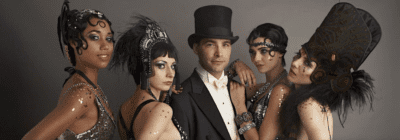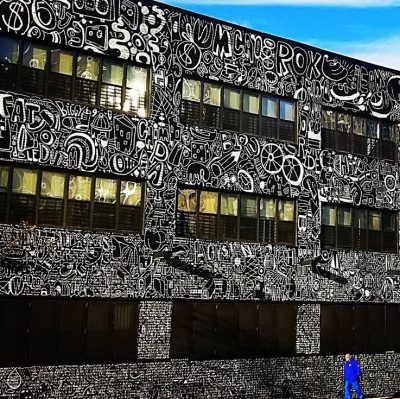Dahl in her 'Claw Machine' (Photo by Andrea H. Perez)
Haley Dahl is loving her ‘movie star moment’
The Sloppy Jane frontwoman and Phoebe Bridgers collaborator discusses her work on A24’s ‘I Saw the TV Glow’
When she isn’t living off the grid in an abandoned California mining town, Haley Dahl is based in Brooklyn, performing gorgeous head-spinning avant-garde chamber pop with Sloppy Jane, a band Dahl formed as a teenager in Los Angeles. After her latest record, “Madison,” which Dahl recorded with 21 musicians in a West Virginia cave, the singer-songwriter is having her first movie-star moment, appearing in writer-director Jane Schoenbrun’s sophomore film, “I Saw The TV Glow.”
In the film, Dahl performs an original song called “Claw Machine” in a fictional dive bar deemed The Double Lunch alongside ex-Sloppy Jane bassist Phoebe Bridgers. Named after those impossible arcade games tucked into the sticky corners of malls and movie theater lobbies, “Claw Machine” features Dahl signatures — soaring orchestral strings, vivid haunting imagery, undulating harmonies and the color blue — but stays rooted in a subtler melodic gloom evoked by dreamy melancholic piano and lyrical snapshots from an adolescence underlined by the insatiable longing for something more.
Pained nostalgia paints the song’s sonic canvas, which implants itself perfectly in Schoenbrun’s film, a surreal and campy A24 release that explores the lives of two teenage wallflowers (played by Justice Smith and Brigette Lundy-Paine) as they navigate ‘90s suburbia while becoming dangerously obsessed with an otherworldly TV show called “The Pink Opaque.”
The dark, sentimental world Schoenbrun creates is enhanced by the film’s soundtrack, which in addition to Dahl, features music by Caroline Polachek, King Woman, The Weather Station, Florist, Frances Quinlan from Hop Along and other artists who weave together a woozy love song to the ‘90s and the unavoidable alienation of growing up.
Dahl sat down with Brooklyn Magazine to talk about working with Schoenbrun, writing from an adolescent perspective, the surrealist films that inspired her as a child and more.
This interview has been edited for concision and clarity.
So how did you get involved in this project?
It was a mix of things. Jane and Phoebe were talking and the head of my record label was music supervising — the stars just aligned. Jane asked me to write something for the film and we decided it would be fun if Phoebe could be featured in it since she was a connecting element. So I wrote the song with both of our styles in mind. I’m the sole writer of the song but it has some awareness of Phoebe’s sensibilities too.
What kind of sensibilities are those?
Well I would categorize my own music as being dark like Phoebe’s, but mine is a bit more grandiose. She’s more solemn and understated, while I am not at all subtle. I tried to balance those two perspectives a lot. I did the arrangements for the music as well — I orchestrate all my own music — and I introduced it with a sparse chord progression on piano, but then had it grow around “my heart is like a claw machine.” It’s a very “me” progression, where it climbs up chromatically and is sort of weird. It’s also a song about being a teenager and Phoebe and I were best friends in high school. There’s a lot of meaning in her being a part of it.
Thanks for describing the sound, I know it can be kind of a tedious task.
No, it’s just that some people have asked if the line “I think I was born blue” is referencing Phoebe’s song “Funeral,” where she says, “Jesus Christ, I’m so blue all the time.” And it actually wasn’t. I wrote that line for a different song a really long time ago. But when it became contextualized in this song, I was aware of Phoebe’s line and I liked the triple parallel. For me, I’m talking about my own sadness, but also that I’m always wearing blue. I have this very monochrome aesthetic in my project and my life; I’m in this permanent state of blueness. And it fits into Phoebe’s lyrical universe too.
I watched your Jam in the Van video from years ago and the blue dye seeping out of your mouth was incredible.
Oh my god. That was like my first taste of going viral. The first people to watch it really hated it and didn’t get it. I had been doing stuff like that for years, like performing nude and vomiting dye, but it was the first exposure I ever really got.
I was reading that Jane Schoenbrun gave you a curated playlist called “Interior Goth Club” to inspire your writing process. Do you remember any of the songs on the mix?
I think “Anthems for a Seventeen Year-Old Girl” was on it and some King Woman songs, which was before Kris [Esfandiari] was even involved in the movie. Jane mentioned “dark” and “nostalgic” and when I read the script I just wanted to write the version of “Mad World” that was in Donnie Darko: sad, moody, teenaged — that was the brand of sadness I was going for.
You seem to enjoy creating and inhabiting worlds in your original music, as well as your performances. What struck you when you were first introduced to the world of the film?
Being introduced to a director named Jane with blue hair and then opening the script and seeing characters throwing up blue dye, plus the stuff about VHS TVs, it just felt very kismet. There were a lot of parallels. Then diving in, I totally fell in love with the script. The one direction Jane gave me was to start the song with the title of the movie.
Interesting. Where did the claw machine image come from?
A lot of times my favorite lyrics are things I’ve said for years without considering them to be lyrics. As early as 2019 I was walking around saying that I have a heart like a claw machine and that I reach and reach but everything is just out of my grasp. That’s been in my head for a long time and I was excited to get to use it.
The claw machine that lives in my head is from the bowling alley in my hometown.
There was one at the roller rink that I would go to as a kid and I would spend all of my money trying to get something out of it when I was like eight. Shout out to Moonlight Rollerway in Los Angeles.
You said recently that when writing “Claw Machine” you were trying to conjure the relentless longing you felt as a teenager, the feeling of being in love with a person you didn’t even know existed. How so?
When I was a kid I was always digging for portals in my backyard. I think I had a big dream that I would meet someone that would swing open a door and I would walk through it and my whole life would change. I wanted love but there was nobody around that I liked at all, so it’s just this empty longing.
It seems to connect to the film well, and the concept of portals also reminds me of “Donnie Darko.”
Totally. I was definitely a portal kid. Portals and amulets. I was always looking for a magic amulet.
“Claw Machine” is built around such vivid imagery told from a teenage perspective. How much of what you wrote is pulled from your own time in high school?
A lot of the lines sound spooky and not literal, but I did have night terrors and insomnia and I did actually paint my ceiling black. I’m usually not that literal in my writing but this one was different. It was the first time I ever wrote about being a kid. So I pulled from my life pretty directly. The last vignette in the song talks about a car crash, which is also real. Phoebe and I got in a car crash in high school where she fender-bendered someone and we had to sit in a parking lot for hours, then have an uncomfortable drive with her dad.
You not only wrote this song for “I Saw The TV Glow,” but you performed it in a scene as well. Is this the first time you’ve been involved in a feature film?
Yeah, it is. And I would love to do it more. I love having my movie star moment. I started out acting as a kid before I moved on to music. And a dream of mine, as an adult, is still to be a rock star, so I like seeing myself on screen. It’s very surreal.
I bet. The film itself is surreal, paying homage to spooky ‘90s classics like David Lynch’s “Twin Peaks” and “Are You Afraid of The Dark.” Are there any shows or films that you remember connecting to growing up?
It’s kind of a weird deep cut, but the most formative film for me, musically and aesthetically, is this live action musical that Dr. Suess wrote in 1953 called “The 5,000 Fingers of Dr. T.” It was not appreciated in its time nor is it appreciated now. But my grandma had a copy of it and showed it to me all the time as a kid. It’s pretty dark. It’s about a boy who dreams his evil piano teacher has a concentration camp for little boys that have to practice piano forever. The set design and the music is fucking insane. I loved it.
You might also like 


























